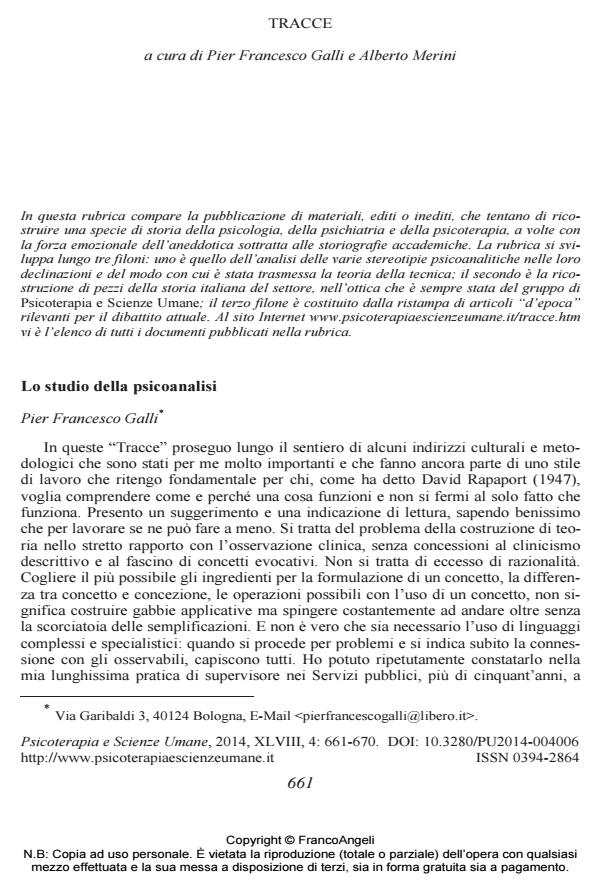Tracce. Lo studio della psicoanalisi
Journal title PSICOTERAPIA E SCIENZE UMANE
Author/s Pier Francesco Galli
Publishing Year 2014 Issue 2014/4 Language Italian
Pages 10 P. 661-670 File size 226 KB
DOI 10.3280/PU2014-004006
DOI is like a bar code for intellectual property: to have more infomation
click here
Below, you can see the article first page
If you want to buy this article in PDF format, you can do it, following the instructions to buy download credits

FrancoAngeli is member of Publishers International Linking Association, Inc (PILA), a not-for-profit association which run the CrossRef service enabling links to and from online scholarly content.
On the occasion of the second Italian edition (from the 15th edition, of 1983) of Eugen Bleuler’s Textbook of Psychiatry (1st original edition: 1916), the Author remembers some aspects of her psychiatric residency training at end of the 1960s at the Burghölzli Psychiatric Hospital in Zurich (at the time directed by Manfred Bleuler, son of Eugen Bleuler), where she went in order to complete also her psychoanalytic training at the "Psychoanalytic Seminar Zurich" (Psychoanalytisches Seminar Zürich [PSZ]) with Paul Parin and Fritz Morgenthaler. Among other things, some traits of Manfred Bleuler’s personality and the atmosphere at the morning meetings he used to chair are described. Some considerations on the end of a cycle of the history of psychiatry, and of a way of conceiving and practicing psychiatric care, are also made.
Keywords: Bleuler, Burghölzli, Zurich, history of psychiatry, psychopathology
- Benedetti G. (1963). Relazione introduttiva: Dialettica della situazione psicoterapeutica. In: Gruppo Milanese per lo Sviluppo della Psicoterapia, a cura di, La psicoterapia delle psicosi schizofreniche. Atti del II Corso di aggiornamento su problemi di psicoterapia (Milano, 23-26 maggio 1963). Milano: Centro Studi di Psicoterapia Clinica, 1963, pp. 5-18. Anche in: Psicoterapia e Scienze Umane, 1968, II, 5: 1-6; 2014, XLVIII, 1: 111-120.
- Elrod N. (1980). Werden Wörter die Psychoanalyse retten? [Le parole salveranno la psicoanalisi?]. ARSP: Archiv für Rechts- und Sozialphilosophie / Archives for Philosophy of Law and Social Philosophy, 66, 1: 103-130 (recensione-saggio del libro di Roy Schafer, A New Language for Psychoanalysis. New Haven, CT: Yale University Press, 1976).
- Freud S. (1922 [1923]). L’Io e l’Es. Opere, 9: 471-520. Torino: Boringhieri, 1977.
- Galli P.F. (2006). In viaggio con i libri: 1959-2006. Psicoterapia e Scienze Umane, XL, 3: 719-735.
- Galli P.F. (2007a). La sfida metodologica di David Rapaport. Psicoterapia e Scienze Umane, XLI, 2: 229-230.
- Galli P.F. (2007b). La psiche delle riforme. Pagine per la riforma, IV, 10/11 (febbraiosettembre, 2° fascicolo): 126-132. Ripubblicato in: Psicoterapia e Scienze Umane, 2008, XLII, 4: 523-534.
- Rapaport D. (1942). Emotions and Memory. New York: International Universities Press, 1950 (trad. it.: Affettività e pensiero nella teoria psicoanalitica. Milano: FrancoAngeli, 1972).
- Rapaport D. (1942-60 [1967]). The Collected Papers of David Rapaport (Gill M.M., editor). New York: Basic Books, 1967 (trad. it. parziale: Il modello concettuale della psicoanalisi. Scritti 1942-1960. Nota introduttiva di Enzo Codignola e Pier Francesco Galli. A cura di Marianna Bolko ed Enzo Codignola. Milano: Feltrinelli, 1977. La Nota introduttiva di Enzo Codignola e Pier Francesco Galli, dal titolo “Modelli concettuali e pratica dell’istituzione psicoanalitica”, è apparsa anche in Psicoterapia e Scienze Umane, 2007, XLI, 2: 234-242).
- Rapaport D. (1947). The psychologist in the clinical setting. American Journal of Orthopsychiatry, 1948, 18, 3: 493-497. Anche in: Rapaport, 1942-60, chapter 24, pp. 299-303 (trad. it.: Lo psicologo nel setting clinico. Psicoterapia e Scienze Umane, 2012, XLVI, 1: 90-94).
- Rapaport D. (1952). Due lettere di David Rapaport a Robert R. Holt del dicembre 1952 (con una Nota introduttiva di Robert R. Holt). Psicoterapia e Scienze Umane, 2012, XLVI, 1: 94-104 (L’intera raccolta in inglese delle lettere tra Rapaport e Holt, che vanno dal 1948 al 1960, è stata poi pubblicata nel 1913, a cura di Holt, sulla rivista telematica International Psychoanalysis: http://internationalpsychoanalysis.net).
- Rapaport D. (1953). Some metapsychological considerations concerning activity and passivity. In: Rapaport, 1942-60, chapter 44, pp. 530-568 (trad. it.: Alcune considerazioni metapsicologiche riguardanti l’attività e la passività. In: Rapaport, 1942-60 [1977], cap. XVI, pp. 321-360).
- Rapaport D. (1959). The Structure of Psychoanalytic Theory: A Systematizing Attempt. In: Koch S., editor, Psychology: A Study of a Science. Study 1: Conceptual and Systematic. Vol. 3: Formulations of the Person and the Social Context. New York: McGraw-Hill, 1959, pp. 55-183. Anche in: Psychological Issues, 2, Monograph 6. New York: International Universities Press, 1960 (trad. it.: Struttura della teoria psicoanalitica. Un tentativo di sistematizzazione. Presentazione all’edizione italiana di P.F. Galli [pp. 9-12; anche in: Psicoterapia e Scienze Umane, 2007, XLI, 2: 231-233]. Torino: Boringhieri, 1969).
- Schafer R. (1976). A New Language for Psychoanalysis. New Haven, CT: Yale Univ. Press.
- Schafer R. (1980). Narrative Actions in Psychoanalysis (Heinz Werner Lecture Series, 14). Worcester, MA: Clark University Press, 1981.
- Schafer R. (1983). The Analytic Attitude. New York: Basic Books (trad. it.: L'atteggiamento analitico. Milano: Feltrinelli, 1984).
- Schafer R. (1992). Retelling a Life. New York: Basic Books (trad. it.: Rinarrare una vita. Narrazione e dialogo in psicoanalisi. Roma: Fioriti, 1999).
- I seminari di David Rapaport del 1957 sulla metapsicologia Paolo Migone, in PSICOTERAPIA E SCIENZE UMANE 3/2020 pp.360
DOI: 10.3280/PU2020-003002 - I seminari di David Rapaport del 1957 sulla metapsicologia David Rapaport, in PSICOTERAPIA E SCIENZE UMANE 3/2020 pp.357
DOI: 10.3280/PU2020-003001
Pier Francesco Galli, Tracce. Lo studio della psicoanalisi in "PSICOTERAPIA E SCIENZE UMANE" 4/2014, pp 661-670, DOI: 10.3280/PU2014-004006